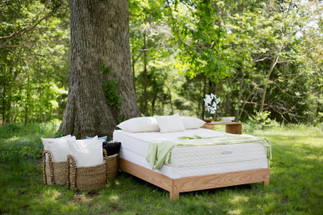Posted by By Talia Rose, Owner of Organic Grace on 30th May 2023
Mattresses and Box Springs
THE PROBLEMS
Personal Health
Since 1973, the U.S. government has required that all mattresses and mattress pads "meet requirements for cigarette ignition resistance," to reduce the risk of bed fires. To comply, mattresses and pads are treated with fire-retardant chemicals—which impart health risks of their own. According to a report released in April by Environment California Research and Policy Center (ECRPC), one of the most widely used (and widely studied) classes of fire-retardant compounds is the polybrominated diphenyl ethers (PBDEs), which have been rapidly accumulating in humans, posing potentially significant health risks. PBDEs are similar in makeup to PCBs—their chemical cousins that have been banned for nearly three decades, because they cause immune suppression, endrocrine disruption, cancer, and behavioral problems, among other ill effects. According to the ECRPC report, exposure to PBDEs may be especially harmful to infants and fetuses, with human studies revealing that these compounds accumulate in breast milk. PBDE levels in the breast milk of Americans are reported to be up to 66 times higher than in that of Swedes. In February 2003, the European Union officially banned the use of some varieties of PBDEs in electronics, effective mid-2004, with more bans anticipated.
Additionally, cotton is often bleached (sometimes with sodium hypochlorite, the manufacture of which releases dioxin), and treated with dyes and color fixers (heavy metals such as chromium, copper, and zinc). Wool, which is a naturally fire-retardant material, is a good alternative since it be marketed without the addition of flameproofing chemicals. But consumers are well-advised to check that the wool is not processed with bleaching chemicals.
To add to this cloud of chemicals upon which most Americans sleep, many mattress cores contain polyurethane foam (which may also be treated with PBDEs) that can emit VOCs associated with upper respiratory problems and skin irritation.
Foundations—the industry term for what most of us call box springs—are often made of hardwood. But some less-expensive box springs are constructed of plywood or particleboard, both of which commonly contain formaldehyde, according to the U.S. Environmental Protection Agency. Some plywood manufacturers also use pentachlorophenol, a probable human carcinogen, to preserve plywood.
Finally, dust mites and their feces are common air pollutants in the bedroom, and can be problematic for asthmatics and allergy sufferers.
Environmental
Conventional cotton production relies on vast amounts of hazardous synthetic chemicals, including pesticides, fertilizers, fixers and dyes. For example, it can take up to 1/3 pound to make one t-shirt. Some other sobering statistics regarding cotton: Non-organic cotton accounts for up to 25% of the insecticides used worldwide, and seven of the top fifteen pesticides used on cotton are classified as at least possible human carcinogens. Additionally, billions of pounds of nitrogen synthetic fertilizers are also used, resulting in runoff that can create aquatic "dead zones" in waterways. In countries lacking good water systems, nitrate fertilizers can reach high enough levels in drinking water from wells to cause "blue baby syndrome" in infants.
Finally, due to cotton's natural resistance to dyes, roughly half the chemicals used as dyes or fixers end up as waste in rivers and soil.
As for conventional wool production, it also involves the use of pesticides on pastures and chemicals in the feed.
Unsustainably harvested wood used in a box spring can have many negative environmental impacts. Each year 30 million acres of tropical forest are cut down and the U.S. continues to lead in wood consumption, representing almost one third of the global wood-buying market.
Social
Many of the chemicals used in cotton, wool and wood production as well as in bedding's manufacturing pose a significant health hazard to those who are in direct contact with them—farm workers and nearby communities.
Farm workers have the highest rate of chemically-related illnesses of any occupational group in the U.S. Nitrogen fertilizers can blind farm workers. Chemical runoff harms communities by polluting the waterways of those who live near or downriver from cotton farms. Synthetic fertilizers have been found to contaminate drinking wells in farm communities.
Poor forest management adversely impacts the workers and the communities in and around forest areas. Rampant chemical use, erosion and soil runoff, and the pollution of vital watersheds can be detrimental to worker, community livelihood and health.
What to look for
The ideal is an untreated, organic cotton mattress. However, there's one caveat: The U.S. Consumer Product Safety Commission oversees the sale of mattresses, stipulating that mattresses purchased in the US pass the cigarette test—a lit cigarette on a mattress pad will cause no more than a 2-inch char with no ignition of the mattress fabric. The mattress is tested in six locations and all must pass. Chemical fire retardants are used on cotton mattresses to meet this standard. As an alternative, though, consumers can opt for a chemical-free wool mattress (wool is naturally fire-retardant). All-cotton mattresses lacking chemical fire retardants are only available to consumers with a doctor's prescription verifying that he or she has chemical sensitivities. Also, some manufacturers comply with federal flammability standards by wrapping their chemical flame-retardant-free mattresses in a layer of wool, bypassing the need for a doctor's prescription.
As for the mattress core, natural latex is the environmentally preferred stuffing, a rubber-tree product that can be sustainably sourced. Some mattresses are stuffed with a mix of natural and synthetic latex, as the latter substance is cheaper (although chemicals are added in the manufacturing process). Both choices are better than the mattress stuffed with polyurethane foam that can off-gas toxins such as toluene. Still other mattress cores comprise an innerspring system and batting, often cotton. Environmentally, organic cotton batting is preferred.
Look for a box spring made from natural, untreated solid wood - preferably sourced from an FSC-certified forest.
If you suffer from allergies, you'll probably want to invest in an "allergen barrier" encasing for your mattress to help keep dust mites away.
What to look out for
Watch out for cotton treated with synthetic dyes or other agents. Even if the cotton used in your mattress is organic and has been grown without fertilizers and pesticides, you've only won half the battle if it is then treated with chemical agents and synthetic dyes. The same is true of untreated cotton that has been conventionally grown. Look for products that are green throughout their entire life cycle.
Steer clear of chemically-treated wool.
Avoid mattress cores with polyurethane foam and box springs/foundations that include particleboard or plywood.
Avoid woods that have been unsustainably harvested.
Product Certifications
"Certified Organic" or "Certified Transitional": Cotton can be certified "organic" or "transitional" according to the guidelines of the USDA's National Organic Program. Organic cotton is grown to organic standards; however, it may well be processed subsequently using bleaches and synthetic dyes.
"Pure Grow Wool": The Organic Trade Association's Fiber Council has been developing organic fiber processing standards for wool and all other fibers including cotton, hemp and flax. In the interim, you can look for wool products that bear the "Pure Grow Wool" label - representing 200 wool-growing families in Sonoma County, California who have pledged to follow sustainable, humane sheep ranching practices, including the elimination of pesticides on pastures and chemical-free animal feed. For example, Crown City Mattresses (see below) contain "Pure Grow Wool."

